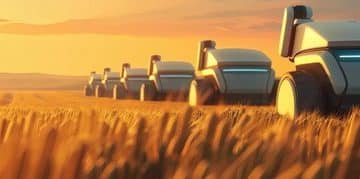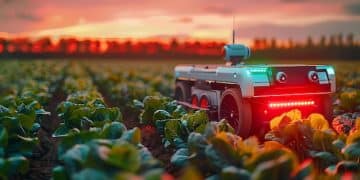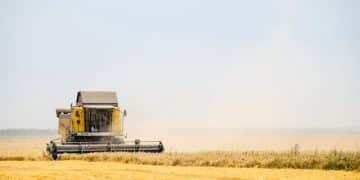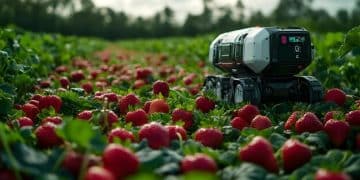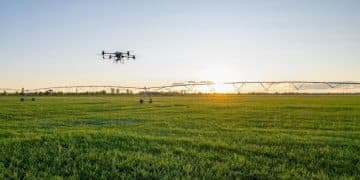Agricultural Robotics: Latest Advances in Weeding and Harvesting
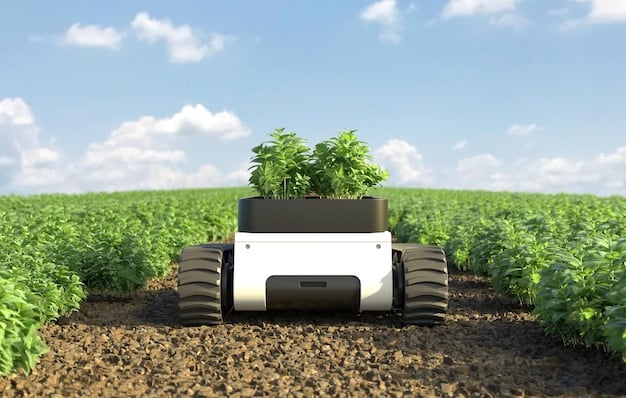
Latest advancements in agricultural robotics include sophisticated systems for precision weeding, autonomous harvesting, and data-driven optimization, enhancing efficiency and sustainability in modern farming practices.
The future of farming is here, and it’s robotic. From the fields of California to the farms of the Midwest, latest advancements in agricultural robotics are revolutionizing how we grow and harvest our food. But what exactly are these advancements, and how are they impacting the agricultural landscape?
The Rise of Agricultural Robotics
Agricultural robotics, once a futuristic concept, is now a tangible reality. Driven by the need for increased efficiency, reduced labor costs, and sustainable farming practices, the integration of robotics into agriculture is rapidly expanding.
These robots are not just simple machines; they are sophisticated systems equipped with advanced sensors, artificial intelligence, and machine learning capabilities. This allows them to perform a wide range of tasks with greater precision and accuracy than traditional methods.
Key Drivers of Adoption
Several factors are fueling the adoption of agricultural robotics:
- Labor Shortages: The agricultural sector is facing a significant shortage of skilled labor, making automation a necessity.
- Increased Efficiency: Robots can work 24/7, increasing overall productivity and reducing downtime.
- Precision Farming: Robotics enables targeted application of resources, minimizing waste and environmental impact.
- Data Collection: Robots can collect vast amounts of data, providing valuable insights for optimizing farming practices.
The transition to robotics is not without its challenges, including the initial investment cost and the need for skilled technicians to maintain and operate the equipment. However, the long-term benefits often outweigh these initial hurdles.
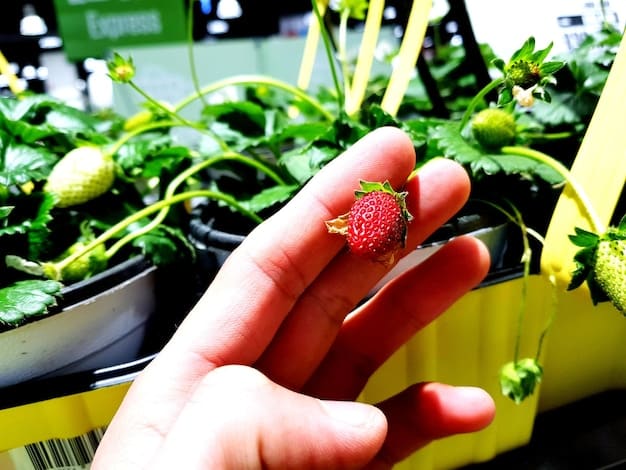
Robotic Weeding: Precision and Efficiency
Weeding is a labor-intensive and time-consuming task, traditionally done manually or with chemical herbicides. Robotic weeding offers a more efficient and environmentally friendly alternative.
These robots use a variety of technologies, including computer vision, laser technology, and mechanical tools, to identify and remove weeds without harming the crops.
Different Approaches to Robotic Weeding
- Computer Vision-Based Weeding: These robots use cameras and image recognition software to identify weeds and selectively remove them.
- Laser Weeding: High-powered lasers are used to precisely target and destroy weeds without affecting the surrounding plants.
- Mechanical Weeding: Robots equipped with mechanical tools, such as blades or tines, physically remove weeds from the soil.
Compared to traditional methods, robotic weeding reduces the reliance on chemical herbicides, minimizes soil disturbance, and lowers labor costs. It also allows for more precise and targeted weed control, improving crop yields and quality.
Robotic weeding is transforming weed management, offering a sustainable and cost-effective solution for modern agriculture. The technology continues to evolve, with new advancements making it even more efficient and versatile.
Autonomous Harvesting: Automation at Scale
Harvesting is another area where agricultural robotics is making significant strides. Harvesting robots are designed to autonomously pick fruits, vegetables, and other crops, reducing labor costs and improving efficiency.
These robots are equipped with advanced sensors, grippers, and navigation systems to navigate fields and selectively harvest crops based on ripeness and quality.
Examples of Harvesting Robots
- Fruit Harvesting Robots: These robots use robotic arms and computer vision to identify and pick ripe fruits, such as apples, strawberries, and tomatoes.
- Vegetable Harvesting Robots: Similar to fruit harvesting robots, these robots are designed to harvest vegetables like lettuce, broccoli, and peppers.
- Grain Harvesting Robots: Autonomous combines and tractors equipped with sensors and GPS technology can efficiently harvest grains like wheat, corn, and soybeans.
Autonomous harvesting robots offer several advantages, including reduced labor costs, increased harvesting speed, and improved crop quality. They can also work in challenging environments, such as at night or in adverse weather conditions.
Advancements in autonomous harvesting are paving the way for fully automated farms, where robots handle every stage of the crop production process. This technology is especially important for large-scale farms that require efficient and reliable harvesting solutions.
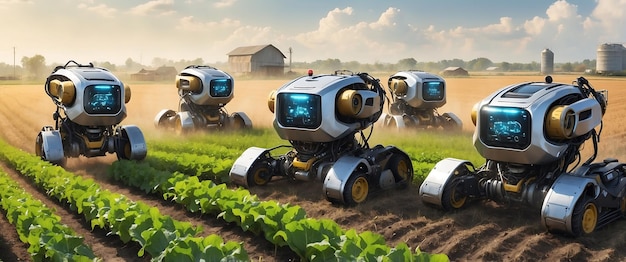
Data-Driven Farming: The Role of Sensors and AI
Agricultural robots are not just about performing physical tasks; they are also powerful data collection tools. Equipped with a variety of sensors, these robots can gather valuable information about crop health, soil conditions, and environmental factors.
This data can be used to optimize farming practices, improve resource management, and enhance crop yields. Artificial intelligence (AI) and machine learning algorithms play a crucial role in analyzing this data and providing actionable insights.
Types of Sensors Used in Agricultural Robotics
- Cameras and Computer Vision: Used to identify weeds, assess crop health, and monitor plant growth.
- Soil Sensors: Measure soil moisture, nutrient levels, and pH, providing insights for irrigation and fertilization.
- Weather Sensors: Monitor temperature, humidity, and rainfall, helping farmers make informed decisions about planting and harvesting.
By combining data from various sources, farmers can gain a comprehensive understanding of their fields and make data-driven decisions that improve efficiency and sustainability. The use of AI and machine learning allows for predictive analytics, enabling farmers to anticipate problems and proactively address them.
The integration of sensors and AI into agricultural robotics is transforming farming into a more precise and data-driven science. This technology is empowering farmers to optimize their operations and achieve higher yields with fewer resources.
Challenges and Opportunities
While agricultural robotics offers numerous benefits, there are also challenges that need to be addressed. These include the initial investment cost, the need for skilled technicians, and concerns about job displacement.
However, the opportunities presented by agricultural robotics are immense. By addressing these challenges and embracing the potential of this technology, we can create a more sustainable and efficient agricultural system.
Addressing the Challenges
- Reducing Costs: As the technology matures and production scales up, the cost of agricultural robots is expected to decrease.
- Providing Training: Training programs and educational resources are needed to equip farmers and technicians with the skills to operate and maintain robotic equipment.
- Creating New Jobs: While some jobs may be displaced by automation, new opportunities will emerge in areas like robotics manufacturing, maintenance, and data analysis.
Agricultural robotics has the potential to revolutionize the way we grow food, making it more efficient, sustainable, and resilient. By overcoming the challenges and embracing the opportunities, we can create a future where robots and humans work together to feed the world.
The adoption of agricultural robotics is not just a technological advancement; it’s a fundamental shift in how we approach farming. This shift requires a collaborative effort from farmers, researchers, policymakers, and technology providers to ensure that the benefits of robotics are realized while mitigating any potential negative impacts.
Future Trends in Agricultural Robotics
The field of agricultural robotics is constantly evolving, with new advancements emerging at a rapid pace. Some of the key trends to watch out for include:
As technology improves, agricultural robots will become more autonomous, versatile, and affordable. This will lead to wider adoption and greater impact on the agricultural sector.
Emerging Trends
- Swarm Robotics: The use of multiple robots working together in a coordinated manner to perform tasks more efficiently.
- Aerial Robotics (Drones): Drones equipped with sensors and cameras are being used for crop monitoring, aerial spraying, and mapping.
- AI-Powered Decision Making: Advanced AI algorithms are being used to analyze data and provide real-time recommendations for optimizing farming practices.
The future of agricultural robotics is bright. As technology continues to advance, we can expect to see even more innovative solutions that transform the way we grow, harvest, and manage crops. This will lead to a more sustainable, efficient, and resilient agricultural system that can meet the growing demands of the world’s population.
The ongoing research and development in agricultural robotics are critical to unlocking the full potential of this technology. By investing in innovation and collaboration, we can accelerate the adoption of robotics and create a more sustainable and productive agricultural future.
| Key Point | Brief Description |
|---|---|
| 🌱 Robotic Weeding | Precision removal of weeds using lasers or computer vision. |
| 🍎 Autonomous Harvesting | Robots that automatically pick fruits and vegetables. |
| 📊 Data-Driven Farming | Using sensors and AI to optimize farming practices. |
| 🛰️ Drone Monitoring | Drones used for crop health monitoring and aerial spraying. |
Frequently Asked Questions
▼
Agricultural robots use cameras and computer vision to differentiate between crops and weeds based on visual characteristics, such as shape, color, and texture.
▼
Robotic harvesting reduces labor costs, increases harvesting speed, minimizes crop damage, and enables harvesting in challenging conditions, such as at night.
▼
Data-driven farming uses sensors and AI to monitor soil conditions, weather patterns, and crop health, allowing farmers to optimize irrigation, fertilization, and pest control.
▼
Yes, agricultural robots reduce the use of chemical herbicides and pesticides, minimize soil disturbance, and optimize resource management, leading to more sustainable farming practices.
▼
The future of agricultural robotics involves more autonomous and versatile robots, swarm robotics, AI-powered decision-making, and the integration of aerial robotics (drones) for comprehensive farm management.
Conclusion
In conclusion, the latest advancements in agricultural robotics are transforming farming practices, offering innovative solutions for weeding, harvesting, and data-driven optimization. While challenges exist, the benefits of increased efficiency, reduced labor costs, and sustainable farming practices make agricultural robotics a key component of the future of agriculture.
